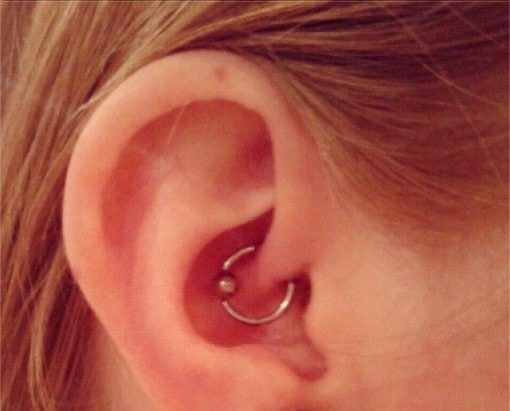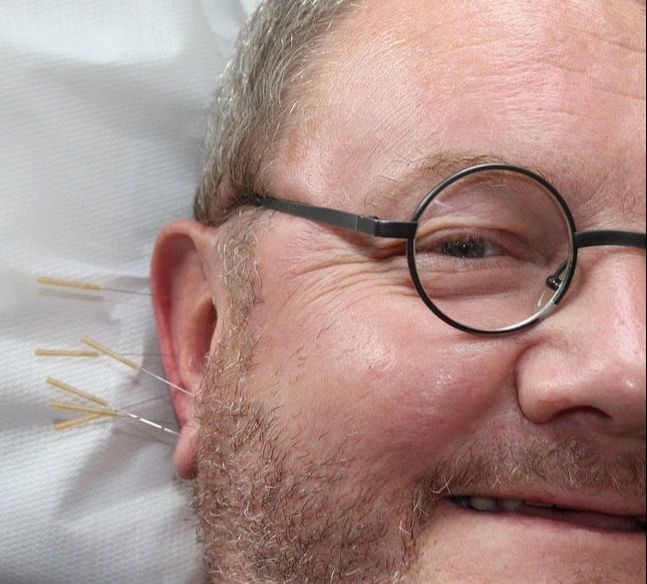SOLUTIONS FOR CHRONIC HEADACHE AND MIGRAINE?
THE DAITH

Over the past few years I have seen numerous patients with the “Daith” ear piercing (see pic above left). My first question to them is always the same, did it work — did it help you with your MIGRAINES / HEADACHES? In the largest number of cases, the answer is yes; in many cases, miraculously so. Two years ago next month the website Migraine Pal did an informal “study” (a survey) which you can read about in an article titled Daith Piercing Results for Migraine from 1,107 Respondents. Although the article is fairly long, I’ve included some cherry-picked results.
“In the long run people seem to consolidate into a positive or negative path. There were fewer people “in the middle” who didn’t change. Most people either improved (64-67%) after one year or got worse (7-9%). 15% reduced their attacks by approximately 10-50%, 7% of people reduced their attacks by half, 24% reduced their attacks by more than half, and 18% of people experienced a full remission in migraine — it eliminated their migraine attacks.
The results are very encouraging, but in reality it is hard to know for sure because people generally prefer sharing good news rather than bad news. The self-selection bias is creates a problem for reliable data. A more robust clinical trial is needed. Some people may also argue that there is a strong placebo effect which may explain the strong early results that you’ve probably seen on social media. This is certainly a very real possibility. However it is worth mentioning that, placebo or not, the results are there.”
Ariculotherapy (Ear Acupuncture) Similar to the Daith

Firstly, even though the work I do goes far beyond (HERE), I’m the world’s biggest fan of the PLACEBO EFFECT. Secondly, the results are encouraging. With 2/3 of the respondents showing improvement — about half of those by 50% or more — this is certainly something to take a closer look at. The bigger question, however, is why. Why does the Daith Piercing work?
In my last post I discussed Chinese acupuncture in relationship to fascia (HERE). A sub-specialty of acupuncture holds that there are points on the ear that correspond to all areas of the body (this is known as auriculotherapy). The Daith is said to pierce an area of the ear that specifically affects the large intestine (we talked about acupuncture and the large intestine yesterday as well). Why might this be a big deal?
For those of you who are up on GUT HEALTH, you already know at least part of the answer. 80% of your body’s immune system is housed in Gut; most of that in the form of BACTERIA living in the large bowel (HERE).
Last November, a team of seven German and Italian researchers teamed up to publish Daith Piercing in a Case of Chronic Migraine: A Possible Vagal Modulation in the journal Frontiers in Neurology. Once you understand the Vagal effect (CNX — Cranial Nerve 10 — the Vagus Nerve) of the Daith on the para-sympathetic nervous system (WHAT HAPPENS IN VAGUS DOESN’T STAY IN VAGUS), it will start to make a bit more sense — especially considering the huge number of people living their lives in a state of SYMPATHETIC DOMINANCE (especially true of migraine sufferers).
Before warning of the potential dangers of a Daith (infection was the biggest) and the fact that they cannot recommend it because there simply are not enough studies out there, these seven neurologists posited why the piercing works for some people.
“We can speculate a vagal modulation as the action mechanism of daith piercing: a nociceptive sensory stimulus applied to trigeminal and vagal areas of the ear can activate ear vagal afferents, which can modulate pain pathways by means of projections to the caudal trigeminal nucleus, to the locus coeruleus and to the nucleus raphe magnus.”
By stimulating the sensory portion of the Vagus Nerve via stimulating the outer portion of the ear (I’ve seen this done with acupuncture needles, electricity, staples, piercings, LASERS, teishin, and an array of other methods), the result is stimulation of the caudal trigeminal nucleus (mostly sensory cells that make up the largest of the nuclei of the 12 cranial nerves) and the lucus coeruleus (an important region for regulating CELLULAR HOMEOSTASIS as well as modulating stress, panic, and wakefulness).
However, the part of this cascade that grabbed my greatest attention was the fact that the nucleus raphe magnus (NRM) is stimulated via this pathway. Listen to what a popular online encyclopedia says of the NRM….
“It seems to participate in the endogenous analgesia system. The main function of the nucleus raphe magnus is mostly pain mediation; it sends projections to the dorsal horn of the spinal cord to directly inhibit pain. The nucleus raphe magnus releases serotonin when stimulated. Raphe-spinal neurons project to enkephalin releasing interneurons….. The periaqueductal grey matter, an area of the brain involved in mediating analgesia, sends efferent connections to the nucleus raphe magnus when it is stimulated by opiates (endogenous or otherwise).
Electrical stimulation of the PAG produces analgesia, as well as administration of morphine to the PAG or nucleus raphe magnus. Similarly, afferent fibres from the spinothalamic tract synapse at the periaqueductal grey matter. This in turn is linked to the nucleus raphe magnus, which when stimulated directly inhibits pain fibers in the dorsal horn of the spinal cord, thus alleviating pain. All of this seems to indicate that the nucleus raphe magnus is part of the endogenous opiate system, and acts to inhibit pain in the spinal cord.”
Although there’s a lot of technical ‘stuff’ here, remembering a couple simple facts can help us figure out the message the authors are conveying. Firstly afferent nerves are generally sensory (they receive impulses) and efferent nerves are generally motor (they are carrying impulses away). The spinothalamic tract carries sensory input from the skin to the thalamus. One of the results is not only increased production of SEROTONIN, but that several different mechanisms in this pathway inhibit or alleviate pain impulses.
Interestingly, I found a study on a device called the NEMOS (Treatment of Chronic Migraine with Transcutaneous Stimulation of the Auricular Branch of the Vagal Nerve: A Randomized, Monocentric Clinical Trial) that was published three years ago this month in the Journal of Headache and Pain that instead of using a Daith, used electrical stimulation. The authors concluded that “29.4% of the patients in the 1 Hz group had over 50% reduction in headache days.” Not bad for a small device that essentially clips to and electrically stimulates the area where the Daith Piercing is done.
So, although there is not enough hard science for your doctor to suggest you get an ear piercing for possible relief of chronic migraine headaches, the evidence is starting to trickle in empirically (it’s always been there anecdotally). Be aware that there are other (very easy) ways to stimulate the CNX (Vagus Nerve) as well — see my earlier link. Also be aware that there are a MYRIAD OF REASONS people get migraines.
For ideas on ways to deal with any number of chronic conditions (headaches included), be sure to check out my “UNIVERSAL CURE” post. And if you know someone who could benefit from this information, by all means send it to them (FACEBOOK is a great way to reach them as well).
